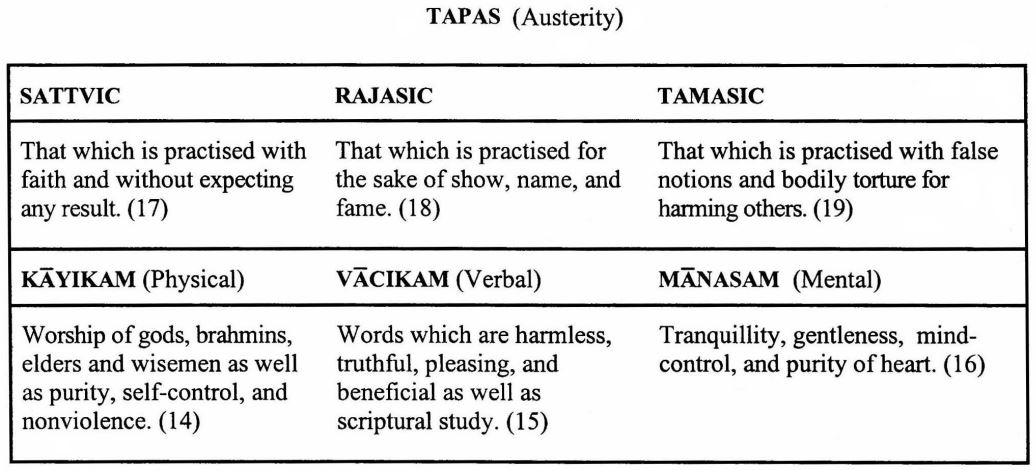
श्रद्धात्रयविभागयोग
Sraddhā-Traya-Vibhāga-Yoga - The Yoga of Differentiating Threefold Faith
In this chapter, the Lord shows how the concept of “guna” that was detailed in the 14th chapter applies to faith, worship, food, sacrifices/rituals, austerities and charity. The Lord explains that these common activities can each be categorized as sattvic, rajasic or tamasic depending on the manner in which they are conducted. Our goal is to engage in only the sattvic varieties since that alone is conducive to spiritual development. Below are the main themes of Chapter 17:
Verses 1 - 6
Arjuna’s question and three types of śraddhā
Verses 7
Kṛṣṇa introduces new topics
Verses 8 - 10
Three types of food
Verses 11 - 13
Three types of yajña
Verses 14 - 16
Three types of tapas (based on instrument)
Verses 17 - 19
Three types of tapas (based on guṇa)
Verses 20 - 22
Three types of charity
Verses 23 - 28
Significance of “om tat sat” and conclusion
Gita Chapter 17 - 28 Verses
Chapter 17 - 28 Verses
Commentary by Swami Paramarthananda
Background
In the previous chapter, Bhagavān said that śāstra is the pramāṇa in determining what is right and wrong and that one should act according to what śāstra says. Based on this, Arjuna raises a question here — “To what category does a person belong if he worships with faith without scriptural knowledge – sattvic, rajasic, or tamasic?” (1)
Kṛṣṇa answers that he may belong to any category according to his temperament. An ignorant person’s faith will depend on his nature since he has no scriptural knowledge to guide. (By observing various types of worship done by others, he develops his faith according to his character. On the other hand, a person who goes by the scriptural teaching will invariably have sattvic faith) (2, 3).
Kṛṣṇa differentiates three types of faith based upon the object of worship (4). Even the nature of worship varies according to faith. People of tamasic faith take to severe practices involving torture of the body etc. (5, 6).
Having answered Arjuna’s question, Kṛṣṇa discusses a few more topics namely food, yajña, tapas and charity, differentiating them into three types based on the guṇas (7 to 22). (Refer to the chart below.) [A seeker has to choose the sattvic type i.e. daivī-sampat and avoid rajasic and tamasic types i.e. āsurī-sampat.]
Bhagavān concludes the teaching mentioning the significance of the mantra “Om tat sat”. This originated from Brahmā’s mouth in the beginning of creation, and has been traditionally chanted during scriptural activities like yajña, tapas and dāna. The word ‘sat’ has many meanings like existence, goodness, good action, steadfastness and an action as an offering to the Lord (23 to 27). [In essence the utterance of this mantra will sanctify scriptural actions and make them sattvic.]
In the last verse, Kṛṣṇa emphasizes the importance of śraddhā (faith). Without faith all scriptural activities become asat, i.e. fruitless (28).
The topics of this chapter are:
- Arjuna’s question and three types of śraddhā: 1 to 6
- Kṛṣṇa introduces new topics: 7
- Three types of food: 8 to 10
- Three types of yajña: 11 to 13
- Three types of tapas (based on instrument): 14 to 16
- Three types of tapas (based on guṇa): 17 to 19
- Three types of charity: 20 to 22
- Significance of “om tat sat” and conclusion: 23 to 28
Since Śraddhā is highlighted both in the beginning and in the end, this chapter is called Śraddhātrayavibhāga-yoga.

Kṛṣṇa divides tapas on the basis of the guṇās and also on the basis of the instrument as given below:


